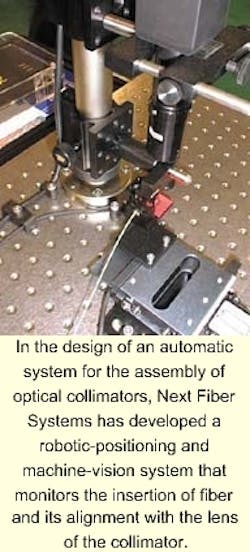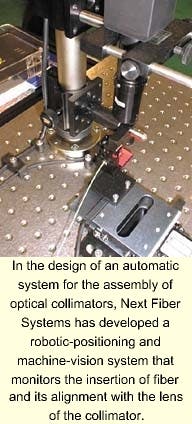System speeds assembly
In today's information transport and telecommunication markets, dense wavelength-division multiplexing (DWDM) subsystems and technologies, optical-to-electrical and optical-to-optical switch fabrics, subsystems, and technologies are competing for market share. Providing automation for complex micro-assembly manufacturing operations is crucial to gaining and maintaining competitive advantage.
To do so, many machine-vision companies are starting new divisions to address this market. A major goal of Next Fiber Systems, a division of Intelligent Automation Systems (Cambridge, MA), is to automate the task of optical collimator assembly. These devices, which consist of optical fiber precisely aligned to a collimating lens, guide parallel light beams through optical devices, such as amplifiers, and collect the beams into a receiving fiber.
In their manufacture, optical fibers must be precisely placed and aligned with lenses already placed in ferrules. This assembly requires microscope operators to measure the plane of light emerging from the lens as the fiber is placed in the ferrule. By measuring the focusing effects of the light, the fiber can be correctly aligned to ensure that the maximum amount of light is transmitted through the lens. To automate this process, Next Fiber Systems has developed a machine-vision system using off-the-shelf imaging components and motor controllers.
"To ensure the optical collimator is assembled correctly," says Steven J. Gordon, Next Fiber Systems president and CEO, "the system images both the top of the fiber and the light emerging from the collimator lens." The PC-based system consists of motorized positioning stages coupled to an imaging system. To ensure that the fiber is correctly placed within the ferrule, the fiber is first placed on a motorized piezoelectric-based nanopositioning system from Bayside Motion (Port Washington, NY).
Under control of an Ethernet-based servo controller from CompuMotor (Rohnert Park, CA), the submicron positioning system is moved under the field of view of a Pulnix America (Sunnyvale, CA) TM72EX CCD camera. Captured RS-170 images that monitor the motion of the fiber into the ferrule are digitized by a PXC-200 frame grabber from Imagenation (Portland, OR) and transferred to the host PC. To check how the light converges output from the lens of the collimator, another Pulnix TM72EX camera is positioned horizontally along the optical axis. Using the multiplexer on-board the PX frame grabber, both RS-170 images are transferred to the host PC.
Custom Software
"As the fiber is moved into the ferrule," says Gordon, "it can be measured using positional image information from the top camera. By correlating this image with the light output measured from the second horizontal camera, the fiber can be precisely placed within the ferrule with no operator assistance," he adds. Rather than use an off-the-shelf image-processing package to perform these measurements, Gordon and his colleagues developed custom image-processing code using Microsoft C++ and Visual Basic.
The user interface, which allows the operator to visualize the placement and alignment of the fiber in the ferrule, was also developed using Visual Basic. "One of the major design criteria in the development of the system," says Gordon, "was to remove the tedious process of manual microscopy from the assembly of telecommunications products. By developing this system, the operator can monitor the automatic assembly of telecommunication devices, such as optical collimators, without the use of a microscope."

